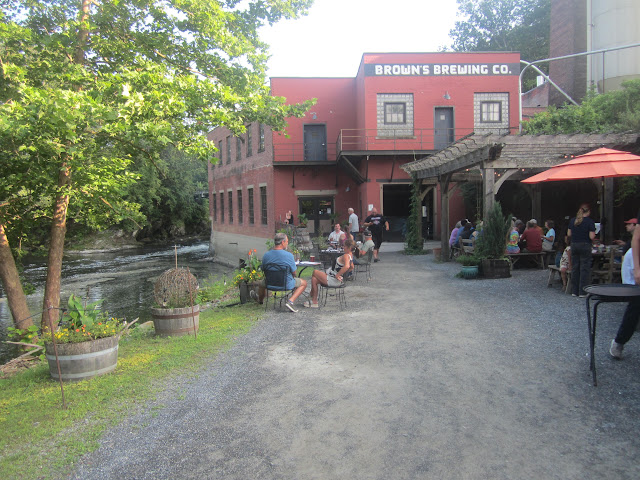Goose Egg Ridge is one of my favorite hikes, and getting there is one of my favorite drives. It's a "the journey, not the destination" thing. You can be in Cambridge caffeinating at the Coffee Canteen and ten minutes later you're walking in the woods. Finish your hike, jump in the truck and in another ten minutes you're sipping a cold one at the Depot.
And those ten minutes on Ashgrove Road are filled with wonder. It's like a greatest hits reel of everything special about Washington County. It begins with the stately Jonathan Dorr-Randall house on the corner of Rt. 313 and its charming, gingerbread trimmed neighbor across the street. A parade of classic white farmhouse/red barn homesteads follow. There's long horned shaggy beasts, puffy sheep and free range chickens. Stone walls, a hillside cemetery and sparkling White Creek are complemented by several small ponds. Spruce and pine line the road and ghostly sycamores shade the stream. The valley is framed by Snake Ridge on one side and the Two Tops cluster of hills on the other. All of that and I almost forgot to mention the Nuns of New Skete and their cheesecakes!
Finally you are greeted by a what looks to be a tree covered pyramid on steroids. Goose Egg! And just beyond, where you take a left onto Bates Road, there's a large, white colonial with a stone wall in front and a red barn across the way. This house always had a strong appeal to me, even before I read the book about one of its previous owners. The book is The Invisible Spy and the owners were Ernest and Margaret Cuneo.
Thomas Maier's recently published book proclaims Ernest Cuneo as "America's first secret agent of World War II", with his future wife Margaret playing a role in British Intelligence. Whether that is hyperbole you'll have to decide for yourself, but there is no denying they were an amazing couple. After a short lived stint as a lineman in the nascent NFL, Cuneo studied law at Columbia and launched a career that soon had such notables as Mayor Fiorello LaGuardia columnist Walter Winchell and eventually Franklin D. Roosevelt seeking his counsel.
These were the years when Hitler was marching across Europe with Britain in his sights. Churchill knew he would need the help of the Americans to withstand the onslaught. To that end he had established a spying operation in New York City, both to counter Nazi influence and nudge this country into the war. Margaret Watson was a young Canadian woman who answered the call to help with the war effort by joining the British Security organization in New York. Her dedication and skills were such that German agents active in the city saw her as a threat to their cause and they tried unsuccessfully to assassinate her.
Ernest became a liaison between FDR's administration in Washington and the British spy network in New York. This is where he met Margaret as well as Ian Fleming and Ivar Bryce, two Brits who would become his friends. Though physically large and quite imposing, Cuneo mastered the art of anonymity, moving discreetly through the halls of power, becoming 'the invisible spy'. Maier's book delves deeply into the war years and the birth of American intelligence agencies with a focus on Cuneo's role.
Eventually the war came to an end but new adventures awaited. Ernie and Margaret were married in 1946 and soon had two kids. His private legal practice was going well and the couple was able to buy a summer getaway home upstate. This is the house at the corner of Ashgrove and Bates Roads. Hardly a mile further down the road, Ivar Bryce and his wife Josephine Hartford owned Black Hole Hollow Farm on the Vermont border. Ian Fleming, the James Bond author, spent several summers at the farm carousing with his friends and attending the Saratoga races. Here, in the deep folds of the Taconics, the British/American spy gang was reunited.
"You might as well have a hell of a time while the voyage lasted, grinding out the juice of each day as if it were the last grape on the vine."
Ernest Cuneo
There are many stories of Ernie Cuneo and Ian Fleming having 'a hell of a time' together. From their exploratory trip across America aboard the Super Chief train to the debacle in the low rent mud baths outside of Saratoga, they both had a lust for life. Consider the time Fleming showed up at Cuneo's house with the idea that they should climb to the top of Goose Egg. You need to know that the usual way up is from the far end of Bates Road onto the ridge and out to the prow. That is grunt enough. To go directly from the Cuneo's house straight to the top is wicked steep (don't ask me how I know). I can only imagine two older guys with many years of indulgent food, drink and smokes behind them clawing their way up. After enjoying the view Cuneo says they descended "Like two whirling dervishes, sweated and happy...laughing like mad."
Unfortunately, adventures Ernie and Margaret had planned for their retirement were cut short when she developed cancer and died in 1976 at the age of 62. She is buried in Washington's Oak Hill Cemetery but has a living memorial locally that few are aware of. On the grounds of Cambridge Central School, out past the playground, at the corner of Rt. 22 and the entrance to the bus garage is a cluster of good sized maple trees. These were planted as saplings in the fall of 1976 by Flax Mill Nursery. This is the Margaret Watson Cuneo Memorial Grove that Ernie created to honor his late wife. When I visited last week (best to go when school is not in session) I could find nothing connecting the trees to the Cuneo family. That's not right. Fighting evil isn't a 'once and done' thing. Kids need to know of the brave people from their community who have put their lives on the line against fascism and would be dictators. A simple plaque and a mention in history class is the least we can offer the Cuneo's for their service to America.
More from the Cuneo files...
* Ken Gottry helped me with research on the Cuneo's. He remembers playing golf and ball with their son Jon, then swimming in the pond in back of their house. Thanks, Ken.
* Ernest passed away in 1988 and his son Jon, also a highly respected lawyer, died in 2023. Jon's widow is Mara Liasson, the NPR political correspondent. The Cuneo's also had a daughter, Sandra, an attorney who lives in the Los Angeles area.
* Susan Barry shared interesting memories of the Cuneo's. If I understand it right, her family once owned Goose Egg, with New York State acquiring it in 1964. One thing that left an impression on her was the outdoor telephone beside the pond in back of the house. This was long before cell phones and Ernest needed to be in constant contact with his clients, even when lounging beside the pond at his summer home.
* Ernie is credited with some of the initial ideas and outlines for a few of the Bond novels. Thunderball's dedication reads: "To Ernest Cuneo, Muse."
* I'm guessing there are still a few locals with memories of Fleming, Bryce and the Cuneo's. It would make a great oral history project to capture some of those memories. Any Cambridge Central students up to the challenge?





.jpeg)

.jpeg)
















































